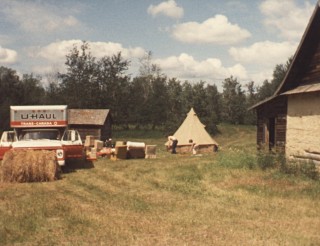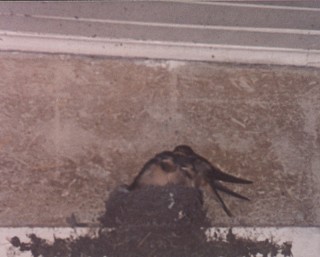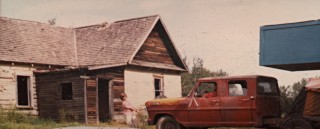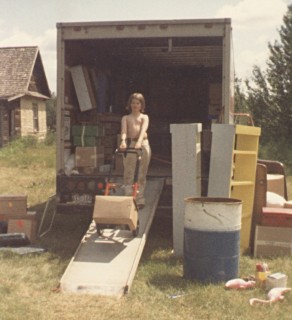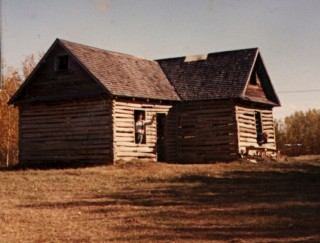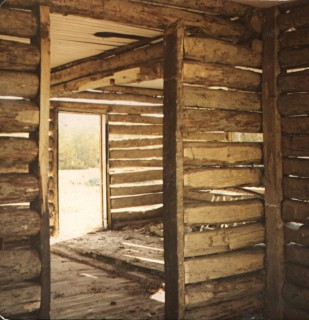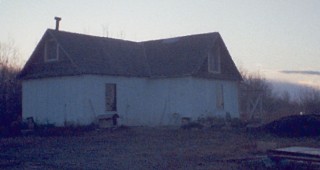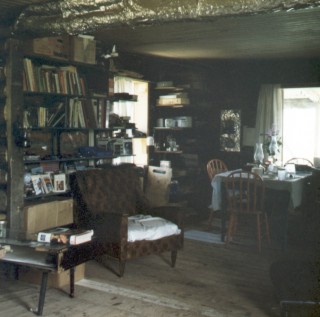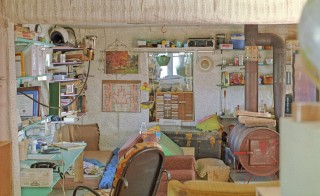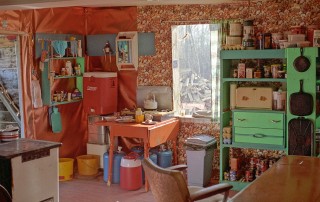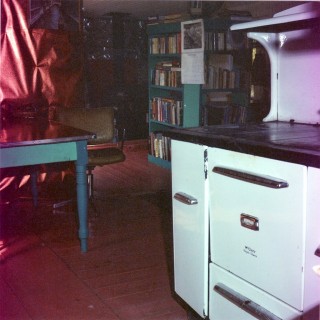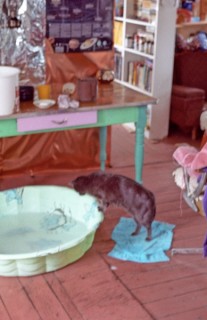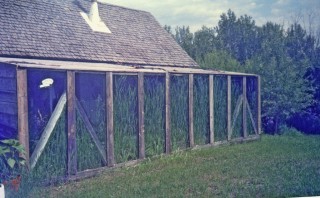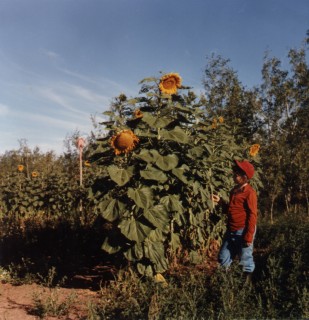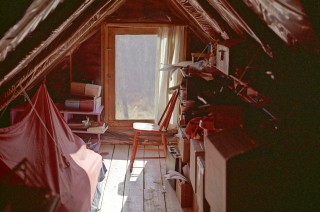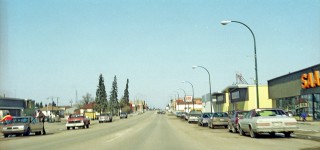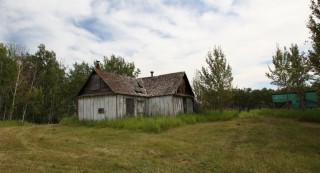Life on (our) farm
People seem to be amused when I tell tales of my life in Manitoba, so I thought I’d post a more detailed account with photos.
In the early 1980s my parents purchased 80 acres in rural Manitoba, with an ancient log cabin on it, and we moved there. I think we stayed for most of three years, and then again for a couple more years in the early 1990s. Today I’ll just talk about the somewhat rustic living conditions I had the pleasure of experiencing.
The cabin was a small three-room affair built of logs and insulated with a mixture of mud, straw and manure, which was common in the pioneer days (judging by what the neighbors told us, this cabin was probably built around 1900, give or take a couple of decades). The attic was of slightly more modern construction, having wooden shingles, a cut lumber frame and adding a finished wood ceiling to the ground floor. It hadn’t been lived in for a long time when we arrived; the windows and doors were long gone and birds were nesting inside.
These photos, taken when we were unloading our moving truck, give some idea of what it looked like and the finish on the walls:
The first thing we (meaning my father) did to make the place habitable was to knock out all the mud insulation
and then fill in the gaps with modern insulation, install doors and enlarged windows, and wrap the outside walls in plywood to deflect the wind. He also knocked out the interior walls to make it feel more spacious, so there was just one room downstairs and one up. After all that, the house looked like this:
Here’s what the interior looked like after we moved our stuff in.
There was no electricity here, and we couldn’t afford to get it installed. On the table to the right you can see a couple of the oil lamps we used for lighting at night.
To brighten things up, we painted the floor and wallpapered the interior with light colored wallpaper and shiny foil. Later we got a Coleman gas lamp, which was really bright but also made a lot of noise and gave off fumes.
In the above picture you can see the oil drum stove my father made – the wood-burning kitchen stove we bought (shown in the kitchen photos below) was insufficient to heat the place in the winter, though it made great bread. If you look closely at the photo below, you can see that we also brought in the propane cookstove from our camper – but that was only good for cooking things and not for heating. We preferred the propane stove for summer cooking because it didn’t produce excess heat and didn’t take time to get going, but the wood stove was essential in winter.
There was no water here. The well that had once been on the property had filled itself in. No streams, and lake and pond water is dangerous to drink. We also couldn’t afford to have a new well drilled, so we had to truck it here ourselves in 5-gallon camping jugs, seen under the orange table in the upper photo. Nearby water sources weren’t reliably clean, so most of the time we got our water from the town of Rossburn, which was about 25 miles away. In the first kitchen photo above, in the corner you can see an antique washing machine that we used to store washing water, and the big camping thermos on top of it was for drinking water. The orange pails on the floor were used to take waste water outside.
No water means no plumbing, of course, and without electricity you do not want to have to use an outhouse in the winter here. Our toilet was a big pail with a seat on it, placed near an upstairs window with a view of the woods, and with a curtain on the indoor side for privacy. It had to be emptied about twice a week. Bathing involved standing in a kiddie pool and pouring water on yourself from a bucket using a cup. Here’s the bathtub set up in the kitchen, as verified by our cat:
In winter we could melt snow for bathing water, so we didn’t have to make water runs quite so often.
The one utility we did get installed was a telephone, which was essential for my father to find work. It was a party line, shared with our two nearest neighbors (1/2 mile and 1 mile distant, respectively). Incoming calls signaled the intended household with distinctive rings – short ring for one, long ring for another, and two long rings for the third. If you wanted to make a call you had to first pick up the handset to verify the line wasn’t already in use. Occasionally a change in the line noise made us suspect that one or another of the neighbors was eavesdropping on our calls.
We also had a battery-powered radio. CBC national radio was pretty darn good in those days, and we passed a lot of time listening to Peter Gzowski’s “Morningside” talk radio, Lister Sinclair’s “Ideas” for science news, Arthur Black’s amusing “Basic Black” op/ed show, and Jackie Farr’s weekend comedy hour “The Radio Show”. I still think of Peter Gzowski as the voice of Canada – there’s no voice that better represents Canadian culture in my mind.
The final major improvement we made was a greenhouse, which my father built using surplus glass from a construction site in Calgary, and old lumber from a derelict barn nearby:
With this and an outdoor garden we were able to grow some of our own food. I also grew flowers, including some giant sunflowers, one of which eventually reached a height of 14 feet.
Our sleeping area was in the attic – we usually slept in individual sleeping bags, zippered up, to help keep the bugs and mice out of our beds. (We would occasionally find a garter snake in the house too, but they never came upstairs, thankfully.)
There was a problem with reading at night though – dozens of brown moths would work their way in through the roof shingles and throw themselves at the oil lamps we usually read by. Not only was it startling and irritating to have moths landing on your head or book while trying to read, it was a bit of a fire hazard because sometimes they would succeed in their attempt at glory, and would fall inside the lampshade and burst info flame – and on rare occasions this heat imbalance would fracture the lampshade too. I switched to using an electric light powered by a car battery, but that required idling the truck to recharge the battery every other day.
We stapled plastic sheets to the inside of the roof to try and keep the moths out, but it wasn’t enough. Eventually I put my bed inside a tent in my wing of the attic, so I could read with only my face and arms poking out, and sleep with the screen closed. Yes, I regularly slept inside a tent inside a house, for practical reasons.
My bedroom, bed-tent on the left. Note the plastic sheeting on the roof, which was not enough to keep the suicidal moths out.
It got a bit chilly here in the winter. We only spent one full winter here, and thereafter found reasons to be elsewhere during the coldest months. Waking up with frost crystals where your breath fell was common enough, but that one Christmas morning we woke up to find the temperature -50°C outdoors, and -30°C inside the house. We spent most of that day either in bed with long underwear and multiple socks on, or in full winter gear with our booted feet in the oven to help warm them up. I don’t think the interior temperature ever got above freezing that day. This is my “get off my lawn” story for Vancouverites or foreigners who complain about it being cold even when water is still liquid. If it had been much colder in Manitoba, we would have had to break off and melt chunks of air to breathe, ya softies! You haven’t experienced a Canadian winter unless you’ve had to light a fire under your vehicle to thaw out the oil so you can start the engine.
There was no rural mail delivery in Manitoba then, though I gather there is now. We had to drive 12 miles to the nearest town, Angusville, to pick up our mail and do our banking. That was a town of about 200 people, and all it had was the post office, bank, a cafe, two mechanics, a small general store and a hotel that wasn’t rebuilt after it burned down. Most of those services are gone now.
We got most of our supplies from the town of Russell, which was about 30 miles in the opposite direction from Rossburn. We made a weekly trip to Russell to get groceries, household goods and to do our laundry, and to entertain me – this town was large enough to have a pizza joint with attached arcade, a pool hall with arcade games, an indoor theater and a drive-in theater. Here’s what the main street looked like back then:
There were two large grocery stores, a clothing store, a Sears catalog outlet, a hospital, a small library, two hardware stores, a drugstore and a couple of passable restaurants – all the luxuries you could want. I tried to spend as much time as possible in the arcade because it was the only chance I got to play video games.
Thanks to its proximity to a valley with hills suitable for skiing, Russell has managed to play up tourism enough to avoid the zombification that has claimed most prairie towns. I returned there recently on my cross-Canada road trip, to see how things had changed. Since we left, our cabin has suffered a lot of deterioration. Animals have broken in through the decaying roof, and the interior is now a disaster zone. I wouldn’t want to go in there without a hazmat suit. Here’s what it looks like from the outside now:
The green thing on the right is the wooden camper my father built, which you might have noticed him removing from the back of the truck in one of the photos at the top. We lived in this now-stationary camper while fixing up the house. The camper is now a giant camper-shaped ant colony.
Overall, despite the rustic conditions, I rather enjoyed my time in Manitoba. It was certainly character-building, anyway. Now, as an exercise for the reader, imagine spending your late tweens and early teens in a place where the nearest other kids were 1.5 miles away and you didn’t see them at school because you were homeschooled. And there was no TV or video games or computers, because no electricity. Radio, music cassettes, books, comics and Lego were what I had. Plus the great outdoors, my family and pets, of course.
I haven’t talked at all about why we moved here, what we did while here, what there was to do in the area, who we interacted with, or why we left. Maybe some other time.
To give you the lay of the land: Map
